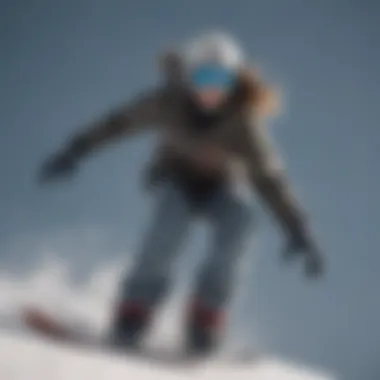Female Snowboarders: Pioneers in Extreme Sports


Intro
The landscape of extreme sports is constantly evolving, and the rise of female snowboarders is a critical part of this transformation. Snowboarding, once predominantly male, has seen an influx of talented women who are reshaping the sport. Their influence is not just limited to participation; it extends to redefining gender representation in extreme sports as a whole. Understanding this shift requires a comprehensive exploration of the historical context, significant athletes, and the social dynamics that have facilitated this growth.
As we investigate, we will highlight how grassroots initiatives and cultural shifts have encouraged more women to engage with snowboarding. We will also address the current challenges they face and analyze the impact of media coverage on female visibility in this sport. The objective is to provide an in-depth understanding of the significant role women play in the snowboarding community, promoting a more inclusive perspective in extreme sports.
Historical Overview of Female Snowboarders
Understanding the historical context of female snowboarders sheds light on the broader narrative of gender inclusion within extreme sports. Female participation in snowboarding not only enriches the sport but also challenges traditional perceptions of women in athletics. This section highlights how early female snowboarders laid the groundwork, reveals the progression and changing nature of women's competitions, and recognizes significant milestones that have marked the evolution of female presence in snowboarding.
Early Pioneers and Their Impact
The rise of female snowboarders can be traced back to the early days of the sport. In the 1980s, women like Timi O'Neill and Michelle Taggart began to carve out spaces for their presence in a male-dominated environment. These early pioneers not only showcased remarkable skill but also served as inspirations for future generations. The obstacles they faced included limited recognition and fewer opportunities compared to their male counterparts. Nevertheless, these athletes proved that women could excel in this challenging sport, fundamentally altering perspectives about female capability.
Evolution of Women's Competitions
As snowboarding gained popularity, organized competitions began to include women. The early contests were often informal, lacking the structure and recognition that characterizes today's events. However, the establishment of events such as the X Games in the mid-1990s marked a turning point. Women's events were introduced, highlighting female talent at a global level. Over time, competitions became more equitable, with increased prize money and sponsorship deals reflecting the importance of women in the sport. Such changes not only uplifted female athletes but also encouraged more girls to take up snowboarding, nurturing a new generation.
Significant Milestones in Women's Snowboarding
Throughout the years, women in snowboarding have achieved notable milestones that deserve recognition:
- The Inclusion of Women in the Olympics: The inclusion of women’s snowboarding in the 1998 Nagano Winter Olympics was monumental. It elevated the sport's visibility and legitimacy on a global stage.
- Record Performances: Athletes like Kelly Clark and Chloe Kim have set and broken records, establishing benchmarks for future competitors. Their successes have redefined what is possible for female athletes in extreme sports.
- Advocacy and Representation: The establishment of organizations and initiatives advocating for women in snowboarding has been crucial. These groups promote equality and ensure that female athletes receive the recognition they deserve.
"The history of female snowboarders is not just a tale of struggle; it is a testament to resilience and progress in a sport that continues to evolve."
This historical overview underscores the transformative journey of female snowboarders, emphasizing their contributions to the sport and the strides made toward a more inclusive future.
Notable Female Athletes
The recognition of female snowboarders is critical in highlighting the strides taken in the world of extreme sports. This segment focuses on notable female athletes whose contributions have not only advanced their sport but have also shaped cultural perceptions about female participation in traditionally male-dominated areas. Understanding their profiles and achievements gives valuable insights into the ongoing transformation within the snowboarding landscape.
Profiles of Influential Snowboarders
Some female snowboarders have served as trailblazers, paving the way for the next generation of women in extreme sports. For instance, Kelly Clark stands out as a prominent figure. Her fierce competition style and commitment helped elevate women's snowboarding on the global stage. Among her many accomplishments, she was the first woman to land a 1080 in competition, a feat that speaks volumes about her dedication and skill.
Another impactful athlete is Jamie Anderson. Known for her creative riding style, Anderson is a two-time Olympic gold medalist. Her emphasis on both performance and artistic elements has changed how judges assess women's events. Further, her advocacy for sustainability within the sport demonstrates how athletes can influence beyond mere competition.
Chloe Kim, the youngest female athlete to win a gold medal in snowboarding at the Olympics, has also gained significant attention. Her social media presence and advocacy for mental health among youth reflect a broader cultural shift towards openness and representation.
These athletes not only excel in their sport but also motivate, inspire, and empower other women to take up snowboarding. Their journeys illustrate the crucial interplay between talent, hard work, and the ability to overcome barriers.
Achievements and Records
The achievements of notable female snowboarders provide a compelling narrative of progress in extreme sports. In various competitions, women have set records that reflect their evolving skill levels.
- Kelly Clark has won multiple X Games medals and was instrumental in Olympic snowboarding, bringing the sport to a wider audience.
- Anna Gasser achieved history in 2017 when she successfully landed the first-ever Cab double cork 1080 in women’s snowboarding, pushing the boundaries of what is possible in the sport.
- Chloe Kim holds the distinction of being a two-time X Games gold medalist and her groundbreaking performances at the Olympics significantly uplifted the visibility of female athletes.
These records not only denote personal accomplishments but also serve as benchmarks for aspiring snowboarders. Each milestone continues to reshape perceptions about women's capabilities in extreme sports.
The ongoing success of these female athletes continues to challenge stereotypes and create a more inclusive environment within snowboarding. Their achievements are not just statistics; they are powerful symbols of progress that aid in dismantling gender biases.


In summary, notable female snowboarders have impacted the sport and contributed significantly to closing the gender gap. Their profiles and accomplishments enrich the narrative surrounding women's participation in extreme sports, making it essential to acknowledge their contributions.
Grassroots Movements Supporting Female Snowboarders
Grassroots movements are fundamental in shaping the landscape for female snowboarders. They establish networks that empower women to participate actively in this extreme sport. These initiatives do not only provide a platform for young female athletes but also foster a sense of community and belonging. Through local efforts, women gain access to resources, training, and mentorship that can often be hard to find in a predominantly male-driven environment.
Local Initiatives and Programs
Local initiatives play a pivotal role in encouraging female participation in snowboarding. These programs often focus on younger girls, aiming to break down barriers and offer support right from the start. Community organizations and local skate parks or snowboarding clubs typically spearhead these efforts. For instance, programs like "Girls Ride the World" and "SheJumps" provide opportunities for girls to learn snowboarding at an early age, reinforcing the message that this sport is for everyone.
Benefits of local initiatives include:
- Creating safe spaces: These programs provide a supportive environment where young girls can develop their skills without the intimidation often felt in male-centric spaces.
- Building confidence: As girls progress in snowboarding, they gain self-esteem and strength that translates to other areas of life.
- Encouraging peer connections: They foster friendships among female athletes, enhancing motivation and commitment to the sport.
The Role of Snowboarding Camps
Snowboarding camps specifically geared towards girls have become increasingly significant. These camps cater exclusively to female athletes, allowing them to learn from qualified female instructors. This focus not only ensures effective teaching but also enhances relatability in coaching. Girls can communicate openly about their experiences and challenges with peers and mentors who understand their journey.
Such camps usually include:
- Skill development: Intensive training sessions that target different skill levels, enabling personalized and focused growth.
- Workshops: These may address broader topics such as the importance of mental resilience in sports, as well as dealing with media representation and self-image challenges.
- Networking opportunities: Camp participants form lifelong friendships and networks that support ongoing engagement in snowboarding.
These grassroots efforts are vital for forging a path for future generations of female snowboarders, ensuring that their voices and talents are recognized in the extreme sports community.
Cultural Shifts in Extreme Sports
The discussion around cultural shifts in extreme sports brings to light critical changes in attitudes and practices related to female participation in these activities. This section highlights the significance of evolving perceptions, the growing demand for inclusivity, and the overall impact these shifts have on the sport of snowboarding. Understanding these cultural changes is essential, as they contribute to the context in which female snowboarders operate and grow.
Changing Perceptions of Female Athletes
Traditionally, extreme sports have been male-dominated arenas, often sidelining female athletes. However, in recent years, there has been a significant shift in how female athletes are viewed. Their capabilities and achievements are gaining recognition. Female snowboarders are no longer just seen as an addendum to men's competitions; they have carved their niche and are celebrated for their talent and resilience.
Factors contributing to this shift include:
- Increased visibility of female athletes in mainstream media.
- The rise of social media platforms allowing women to share their stories and successes.
- The growth of sponsorship opportunities targeting female athletes.
The result is a more balanced representation in the sport. Brands and media outlets are realizing the importance of gender diversity in their narratives, which in turn influences public perception and engagement with female athletes.
"The rise of female snowboarders reflects not just skill but also the power of representation in inspiring the next generation."
Diversity and Inclusion in Snowboarding
Diversity and inclusion have become central themes in the evolution of snowboarding. As the sport matures, there is a concerted effort to welcome a broader spectrum of athletes. This is not limited to gender but also encompasses race, ethnicity, and class. By fostering a more inclusive environment, the sport attracts a richer tapestry of talent, which enhances its overall vibrancy.
Key benefits of promoting diversity include:
- Increased participation rates among different demographics.
- A wider variety of styles and approaches within the sport.
- Enhanced community support through diverse grassroots initiatives.
Moreover, the acknowledgment of diverse backgrounds helps challenge stereotypes. As female athletes from various backgrounds emerge and succeed, they serve as role models, encouraging others to engage in the sport. The collaboration among diverse individuals enriches the snowboarding community, ensuring it remains dynamic and relevant in today’s society.
Challenges Faced by Female Snowboarders


Understanding the challenges faced by female snowboarders is essential for grasping the current landscape of the sport. These challenges affect performance, participation, and the visibility of women within the snowboarding community. Navigating obstacles provides insight into how the sport can genuinely evolve to be more inclusive. When women encounter barriers, it not only hampers their individual experiences but also perpetuates a cycle of underrepresentation in extreme sports.
Access and Opportunities
Access plays a crucial role in the world of snowboarding. Female snowboarders often face limitations related to funding, training facilities, and supportive networks. Unlike their male counterparts, they may struggle to find local resources that cater specifically to them. This can lead to fewer opportunities to develop skills in a competitive environment. For aspiring athletes, the lack of accessible coaching and scholarships means they often have to rely on personal determination to break through.
The visibility of female athletes at events is another significant factor.
“The struggle for female snowboarders continues, often driven by a landscape dominated by male athletes and perspectives.”
Many competitions do not provide equal representation, making it difficult for women to gain meaningful exposure. As a result, they may not attract the same level of sponsorship and media attention compared to male athletes. This can create a snowball effect, where less funding leads to fewer competitive opportunities.
To improve these access barriers, some organizations are working to create programs specifically designed for women. These efforts can take the form of camps, competitions, or mentorship opportunities. Also, raising awareness within the snowboarding community about the importance of equal access can facilitate systemic changes in how resources are allocated.
Media Representation Issues
Media representation is an area that requires attention for female snowboarders. Historically, coverage of extreme sports has focused predominantly on male athletes. This has created stereotypes and narratives that undervalue the contributions of women in the sport. Female snowboarders often see less airtime during broadcasts or feature articles, resulting in a lack of recognition for their achievements.
The limited portrayal in media does not accurately reflect the talents and skills of female snowboarders. When they do get coverage, it can sometimes focus on superficial aspects rather than their athletic abilities. This reinforces a misconception that women are not as capable in extreme sports.
Efforts should be made to enhance female visibility through diverse media campaigns and inclusive storytelling. Highlighting the stories of female athletes can change perceptions and encourage new participants in the sport. Female athletes must take the narrative into their own hands—social media serves as a platform where they can showcase their skills and stories directly.
Impact of Social Media on Female Snowboarding
The rise of social media has significantly reshaped the landscape of female snowboarding. It offers platforms where athletes can connect, share their stories, and showcase their abilities to a broader audience. This visibility plays a crucial role in fostering a supportive community and elevating female participation in extreme sports. Rather than relying solely on traditional media, social media empowers female snowboarders to take control of their narratives.
Building Online Communities
Social media platforms like Instagram, Facebook, and Reddit serve as vital spaces for female snowboarders. They facilitate the creation of online communities where athletes can interact, share tips, and provide encouragement. These platforms have made it easier for new and seasoned snowboarders to find their tribe. By forming these communities, athletes cultivate a sense of belonging and solidarity, which is essential for navigating the challenges associated with extreme sports.
The presence of influential female snowboarders online also empowers younger athletes. They can follow their favorite riders, learn from their experiences, and witness their journeys. This access breaks down barriers that once prevented female athletes from feeling included in the snowboarding world. Supportive online dialogues contribute significantly to personal development and confidence building.
Showcasing Talent and Skills
Social media serves as a powerful tool for showcasing talent and skills. Female snowboarders use platforms to post videos of their runs, tricks, and achievements. This visibility can lead to increased recognition and opportunities, such as sponsorships or invites to professional competitions.
The ability to easily share content means that athletes can gather feedback and improve their performance more effectively. Training sessions can be documented, allowing for self-reflection and progression tracking. High-quality footage fosters a competitive yet supportive environment, motivating others to push their limits.
Moreover, the viral nature of social media posts can catapult lesser-known athletes into the spotlight. One remarkable video can lead to a surge in followers and potential endorsements. Social media has become an incubator for talent, enabling female snowboarders to break through traditional media barriers and gain rightful recognition.
"Social media has changed the way we interact with athletes and supported the rise of female participation in extreme sports. The visibility provided creates both opportunities and inspiration for many."
The impact of social media on female snowboarding cannot be overstated. It continues to redefine how athletes engage with each other and their fans. Therefore, understanding this development is crucial for anyone invested in the future of snowboarding.
Economic Aspects of Female Participation
The economic dynamics surrounding female snowboarders are crucial to understanding their rise in the sport. This section delves into the financial aspects of female participation, examining how sponsorship and merchandising are shaping the future for women in snowboarding. By evaluating these financial avenues, we can see how they influence women's participation and visibility in extreme sports.
Sponsorship Dynamics
Sponsorship is a vital component in sports, providing athletes with necessary funding, equipment, and promotional opportunities. In snowboarding, companies are starting to recognize the potential of sponsoring female athletes, which is a shift from previous focus mainly on male athletes.


The involvement of brands like Burton and Ride Snowboards underscores a growing trend. Supporting women in the sport not only benefits female athletes but also enhances a brand’s image, appealing to a more diverse audience. Sponsorship deals are becoming more common, but they still have room for growth.
"The landscape of sponsorship is changing, and brands are beginning to understand the value female athletes bring to their marketing strategies."
The challenge remains. Many female snowboarders still face difficulty securing sponsorships comparable to their male counterparts. This discrepancy highlights the need for greater advocacy and promotion of female athletes. Initiatives that educate brands about the impact of female sponsorship can lead to more equitable funding in snowboarding.
Merchandising and Market Trends
Merchandising represents another significant economic avenue for female snowboarders. As the popularity of women's snowboarding grows, so does the market for female-specific equipment and apparel. Brands are increasingly innovating products tailored for women, which shows recognition of this expanding demographic. The growth of female consumers in snowboarding has led to a rise in specific apparel lines, such as never summer, aimed directly at female athletes.
Market trends indicate an increase in sales of these products, correlating with the rising visibility of women in the sport. Consumers are drawn to brands that represent their values and interests. This creates an opportunity for female snowboarders to not only benefit from endorsements but to also collaborate on merchandise designs that resonate with the female athlete experience.
Future Prospects for Female Snowboarders
The future prospects for female snowboarders indicate an exciting trajectory for the sport. This consideration is crucial for understanding the expanding role women are playing in snowboarding. The ongoing evolution hints at increased opportunities for female athletes within the industry. Specifically, attention to growth areas and the role of emerging technologies will shape the landscape.
Potential Growth Areas
The attention to women's snowboarding has grown in recent years. Some key growth areas include:
- Increased Participation Programs: As more initiatives arise, we see more young girls getting involved in snowboarding.
- Expanded Sponsorship Opportunities: Brands are increasingly recognizing the value of female athletes. This shift creates more avenues for funding.
- Enhanced Media Coverage: Coverage of women's events is on the rise, leading to greater visibility.
- Development of Women's Competitions: New competitions specifically for women can foster talent and camaraderie among athletes.
These areas highlight the growing recognition of female snowboarders in extreme sports. The direct involvement of communities in nurturing female talent is pivotal. Increased trust and support can ensure sustainability, thereby encouraging long-term engagement in snowboarding.
Role of Emerging Technologies
Emerging technologies offer numerous advantages that can benefit female snowboarders. Here are some areas to consider:
- Wearable Tech for Performance Monitoring: Devices that track performance can help athletes fine-tune their skills.
- Virtual Reality Training Tools: VR can provide unique learning experiences in a controlled environment.
- Online Platforms for Accessibility: Digital marketing enables athletes to build personal brands and engage with followers.
- Innovative Snowboard Designs: Advances in material science could lead to boards better suited for female riders.
These technologies not only empower female athletes but also enhance their experience in the sport. As technology continues to evolve, it is vital that female snowboarders embrace these changes to stay competitive.
"The rise of female snowboarders signals a broader change in extreme sports, promoting equality and representation."
In summary, the future of female snowboarders looks promising. Locking in the potential growth areas and embracing emerging technologies can help athletes flourish. As the sport continues to adapt, the sustained efforts of athletes and supporters will further solidify the place of women in snowboarding.
Concluding Thoughts on Female Participation in Snowboarding
The journey of female snowboarders reflects a significant development in the extreme sports landscape. This article has explored the various aspects of women's rise in snowboarding, from historical milestones to current challenges and future prospects. Understanding this trajectory is essential for appreciating the depth of female contributions to the sport. It emphasizes the need for continual support and recognition, which can catalyze further advancements in gender representation.
Reiterating the Importance of Representation
Representation in snowboarding is more than a numbers game; it shapes perceptions and inspires the next generation. When young female athletes see role models like Chloe Kim and Jamie Anderson excelling in their sport, it sends a powerful message. Representation helps to normalize female participation in extreme sports, breaking down stereotypes that have persisted for years.
The visibility of female snowboarders helps to foster an inclusive environment. Increased representation leads to more female athletes participating, which can drive greater interest and investment in women's events. Additionally, it boosts the visibility of female talent, allowing them to secure sponsorships and support that were previously difficult to attain. This process of normalization is crucial not just for females, but also for the sport as a whole, encouraging diversity and innovation.
Call for Increased Support and Recognition
Despite the progress made, there remains a noticeable gap in support and recognition for female snowboarders. It is paramount that sponsors, event organizers, and media outlets increase their focus on highlighting female athletes. Increased financial backing and visibility through innovative marketing strategies can aid in leveling the playing field.
The community also has a role to play in advocating for female athletes. Engaging with local initiatives and programs can create opportunities for women in snowboarding.
"The future of snowboarding hinges on our ability to recognize all athletes, regardless of gender."
This call to action is not just about equality; it is about enriching the sport. By fostering an even playing field, we can unleash a wave of untapped potential.
In summary, emphasizing representation and escalating support for female snowboarders can transform the sport. The benefits are manifold, encompassing broader participation rates, increased diversity, and heightened competition. Recognizing women in snowboarding is pivotal to shaping its future.



